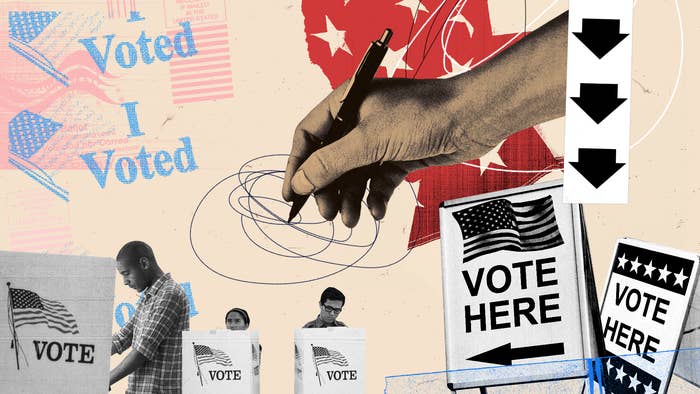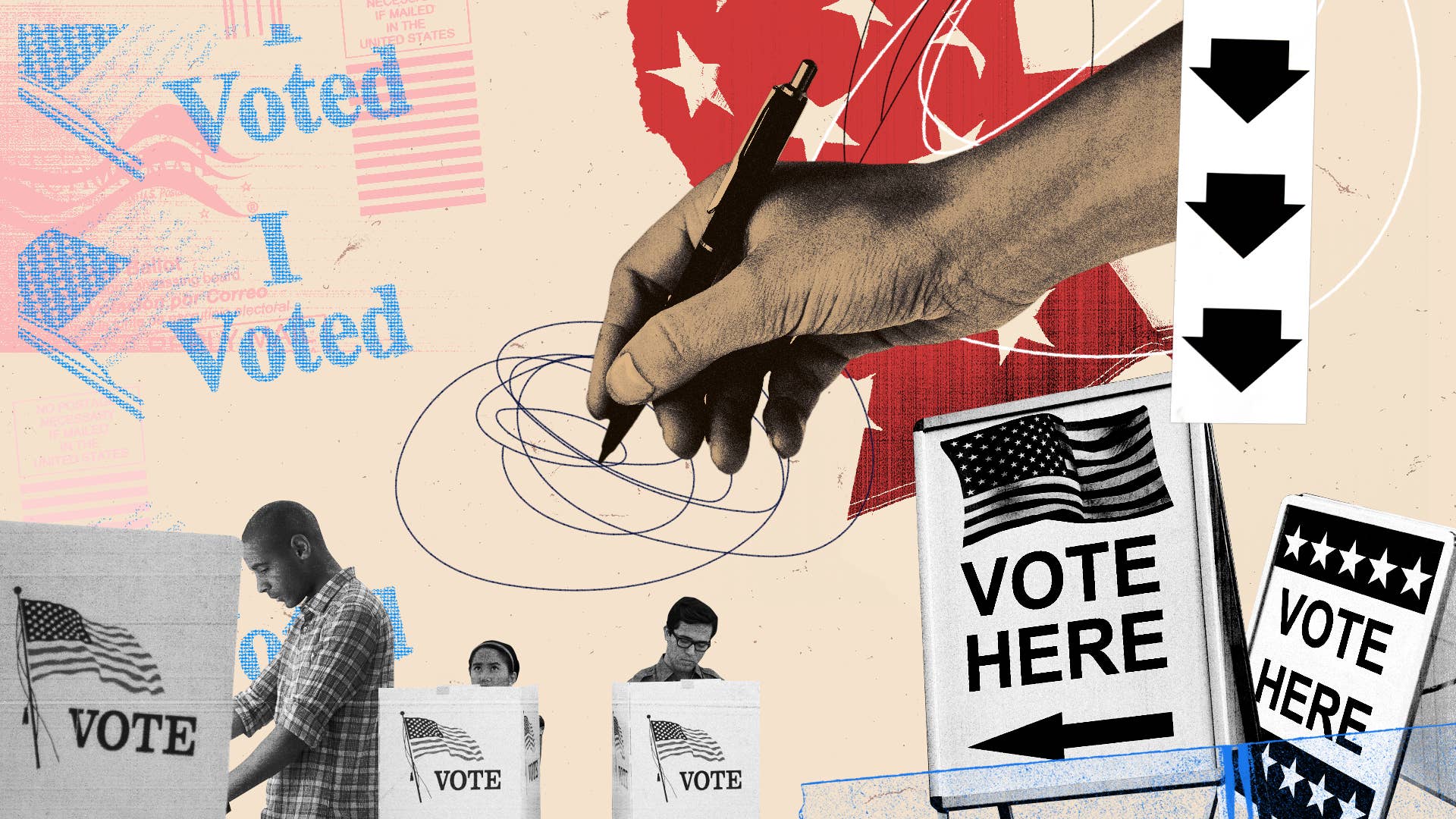
Young voters could decide the outcome of almost any election. The problem is that not enough of them vote. The number of U.S. millennials in 2019 surpassed that of baby boomers for the first time, according to U.S. Census Bureau data. For the 2020 presidential election, millennials and members of Gen Z who are eligible to vote easily make up the largest voting bloc in the country, per the Pew Research Center.
But eligibility doesn’t win elections. Despite college campuses serving for decades as hotbeds of political thought, speech, and activism, young voter turnout still falls well short of that of previous generations. In the 2016 presidential election, for example, 69 percent of eligible baby boomers said they voted, while only 51 percent of eligible millennials could claim the same.
Though overall turnout increased since then, younger turnout was still bested by senior generations, according to a census bureau analysis of the 2018 off-year election.
Why is it important for students and young people to vote? You could go on and on, and on and on, about this, but what it boils down to is control. Baby boomers aren’t going to be around for too much longer and won’t face the dire consequences of a constantly heaving economy, climate change, and whatever kind of geopolitical insanity President Trump’s Space Force will unearth. Voting is as much of a right and responsibility as it is an investment in yourself, your community, your family, and your future. It is control, and below you’ll learn about what you need to do in order to take it.
First-time registering
It’s impossible to say which part of the voting process is most important, but there’s a strong case to be made for registering. It’s what gets your name on the list, and it’s what ensures your ballot is printed. It’s what guarantees the government can hear you over all of the noise. Voters register with the county of their primary residence or, in the cases of students in some states, where they are living. Registration can be done on paper and mailed, or it can be done online or in person.
There are deadlines for certain elections in certain states, so if upcoming elections this summer or fall will be your first time casting a ballot, the time to register is right now. Websites like Vote441 and StudentVote provide deadlines for wherever you live and can help get you registered in as little as two minutes.
You can also download, print, and complete the National Voter Registration Application Form, which includes details on what forms of identification are needed for each state and where to mail them. Things can also be confusing for first time voters living away home and seeking to cast a ballot. Some states will allow you to register to vote from your campus address or your parents’ home address. Others might require one or the other. Check out this map from the Campus Vote Project and click on your state to see what you need to do.
While registering, you’ll be asked whether you also want to register with a political party, such as the Democrats or Republicans. While they are the largest, best-known parties and sources of all presidents and most members of Congress since 1852, there are in fact a number of other political parties in the U.S., including the Libertarian Party, the Green Party, and the Legal Marijuana Now Party.
But before getting too deep into political philosophy, what’s most important to know about registering with a party is that, in many states, it is also the means by which voters within each party decide who will represent them in general elections. A dozen states have closed primaries, meaning that only registered members of each party can vote on candidates to send to the general election. Fifteen states have open primaries that allow voters to cast a vote with any party’s first selection round. There are also a variety of hybrid systems, all outlined and specified by state by the National Conference of State Legislatures (NCSL).
One of the most important parts of registering is deciding the way you’re going to vote. Voters can cast their ballots early, on election day, by mail, or absentee. The latter category applies to those who for some reason, such as being deployed overseas on military assignment, are unable to make it to the polls. Voting by mail has boomed in recent years, and some states now automatically mail ballots to voters to voters. They must be requested in other states. Check with your state or county for rules applicable to where you live.
What’s most important to remember about mail-in ballots is to completely read all directions, then read them again. Mail-in voting is expected to surge this year as the novel coronavirus continues to cripple the economy and people’s daily lives. In California, tens of thousands of mail-in and absentee ballots were rejected for arriving after late. Hundreds of thousands of mail-in ballots in recent years have been rejected after voters failed to sign either the return envelope or the ballot itself. While the issue has sparked dozens of lawsuits, this should drive home the point to read your ballot carefully, and at least once.
Do the research
The only way to undermine your ballot is not to know what you’re voting on, or about the candidates running for office. Candidate forums, debates, and websites are where you can hear those running for office speak for themselves. Reporters for reputable media organizations check candidates’ claims and statements, as well as those supporting or opposing ballot initiatives, against research and factual history. PolitiFact is an invaluable source for verifying whether politicians’ claims are true, false, or somewhere in between. Snopes is a good way to confirm that your crazy uncle’s conspiracy theories are in fact crazy.
When doing research, remember that all sources are not created equal. Blogs, citizen journalists, obscure partisan news networks, and websites should all be questioned and sometimes avoided. More often than not, political parties or supporters of particular issues will create what appear to be news sources but that in truth exist only to support a particular individual or view point. Instead, seek trusted, transparent sources like reputable research journals and news outlets, publications with data citations, and research organizations with ties to academic institutions. If the website ends with .org or .edu, you could be in the right place, but even then, insist on asking questions.
Know the what, when, and where
After registering, you’ll receive a voter card with your name, information, and, most important, your voting location. Do a quick search for your voting location before Election Day. Make sure you know where it is, whether there might be traffic, and the parking situation. The good news is that most polling places are open for 12 hours on the day of the election. Many people like to vote first thing in the morning or during their lunch hour to make it fit their schedules.
For those with busy schedules, 27 states allow for early voting giving you a wider time and hopefully more convenient time frame to cast your ballot. Some states require no additional steps in order to cast an early ballot. Visit vote.org to see schedules and requirements for early voting in each state.
What’s most important is to know what you need to bring in order to vote. Thirty-six states have laws requiring voters to to show some sort of identification at the polls, according to the NCSL. In Washington, D.C. some first-time voters are required to bring identification, which might be required for returning voters. Find a complete list of what you’ll need by state here.

Pull up & vote
By the time Election Day arrive, all the hard work should be done. You’re registered, you’ve requested a sample ballot, you know where you’re going, you know what you need, and you know what to do. It should all be easier than an open-book test. The only thing left is to actually do it.
Despite what you hear and read, voting is a simple, quick, and rewarding experience. You registered. You spent some time learning about the candidates and issues via reliable, fact-focused sources. Memes are great, but they’re not a good source of information and are mostly there to conjure up gut impulses and emotions rather than facts. The same goes for social media. Don’t get played. You filled in your ballot and mailed it (on time and signed), or you voted early or on Election Day itself. It’s time to start thinking about the next election.
While the presidential election that takes place every four years and off-year elections—when senators and congresswomen and men face the electorate every two years—seem to get the most attention, there are in fact elections throughout the year in almost all states. During some elections, there could be a variety of issues beyond the candidates. Statewide referendums, local ordinances, and even states court judges could be on your ballot. The decisions on that sheet, or those sheets, of paper are counted by your county’s elections departments and, if need be for statewide races, filtered up to the state capitol when they’re certified by secretaries of state.
Other than the Electoral College, which is the body that actually decides who can claim the presidency, after your ballot is cast, it’s your county’s elections department that will tabulate results and announce them once counting is finished.
Helpful advice for first-timers and college students
What’s most important to know is that going to the polling place isn’t being shoved out on your own for some sort of vision quest. If you’ve just become eligible to vote or are voting for the first time, federal law allows poll workers to assist those who ask for help, including those with disabilities. Sometimes, even experienced voters can be confused by new voting hardware. This isn’t the SAT exam. Put a hand up and make sure you get things right.
Many polling places will be swarmed with election volunteers hoping to make one last pitch on behalf of their issue or candidate. Volunteering and civic mindedness are an important part of American Democracy; however, you’re not required to listen to them, and they are required by law to stay a certain distance from the polling place’s entrance. In Alabama, it’s 30 feet. In Alaska, it’s 200. While we encourage courtesy and kindness, know that you’re not required to talk to them, take any of their flyers or literature, or tell them how you voted on the way out. Just keep moving.
When it’s done, the first question you might ask yourself is, “That’s it?” If you did your research and the line wasn’t too long, voting is a quick, easy experience. Don’t let that diminish its importance or meaning. Voting at the dawn of American history was reserved for white, male property (slave) owners. The vote wasn’t extended to African-Americans until the passage of the 15th Amendment in 1870, and even then the country was still plagued by a century of unconstitutional poll taxes, literacy tests, and racist menacing seeking to prevent people from voting. Women didn’t get it until in 1920.
If history makes your eyes glaze over, just know this: Voting is how things get better. Not voting isn’t a statement; it’s ignorance. Change doesn’t happen overnight, but when people are able to educate themselves about the issues affecting their lives, and vote on them, we get a little bit closer to that elusive vision of the kind of place we want to call home.
Also, head to Complex's Pull Up & Vote page to be registered for the 2020 election, request a ballot, or double-check your registration to make sure you can do your part!

